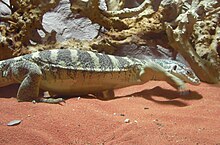This article needs additional citations for verification. (June 2020) |
Spencer's goanna (Varanus spenceri), also known commonly as Spencer's monitor, is a species of Australian monitor lizard.
| Spencer's goanna | |
|---|---|

| |
| Cologne Zoological Garden | |
| Scientific classification | |
| Domain: | Eukaryota |
| Kingdom: | Animalia |
| Phylum: | Chordata |
| Class: | Reptilia |
| Order: | Squamata |
| Family: | Varanidae |
| Genus: | Varanus |
| Subgenus: | Varanus |
| Species: | V. spenceri
|
| Binomial name | |
| Varanus spenceri | |
Etymology
editThe specific name, spenceri, is in honour of English-Australian biologist Walter Baldwin Spencer.[2]
Geographic range
editSpencer's goanna is found in eastern Northern Territory and northwestern Queensland, Australia.[3]
It is native to the Barkly Tableland.[citation needed]
Description
editSpencer's goanna can grow to a total length (including tail) of up to 120 cm (47 in). Spencer's monitor is generally heavier than a similarly sized monitor of another species due to its "stockier" build. It has sharp claws which it uses for digging burrows.[citation needed]
Diet
editSpencer's goanna eats anything it can find, including highly venomous snakes, small mammals, small lizards, eggs, and carrion (dead animals), and is able to digest anything it eats.[citation needed]
Defensive behaviour
editSpencer's goanna has unusual defensive behaviour, where it feigns death when threatened; the body is flattened against the ground, one hind limb is extended while all other limbs held close to the body, and the tail is contorted into a wavy shape. The head is kept up to observe the threat, feigning death until the threat has left the area. [4]
Habitat
editThe preferred natural habitat of Spencer's goanna is grassland.[1]
Living in black soil plains with no trees, Spencer's goanna is the only Australian monitor that does not readily climb, although juvenile animals will climb given the opportunity.[citation needed]
Reproduction
editClutch size of Spencer's monitor generally ranges between 11 and 30 eggs.[5]
Taxonomy
editVaranus ingrami Boulenger, 1906, is an invalid name (a junior synonym) for this species.[3]
References
edit- ^ a b Shea, G.; Hobson, R.; Amey, A. (2018). "Varanus spenceri". IUCN Red List of Threatened Species. 2018: e.T83778868A101752365. doi:10.2305/IUCN.UK.2018-2.RLTS.T83778868A101752365.en. Retrieved 18 November 2021.
- ^ Beolens, Bo; Watkins, Michael; Grayson, Michael (2011). The Eponym Dictionary of Reptiles. Baltimore: Johns Hopkins University Press. xiii + 296 pp. ISBN 978-1-4214-0135-5. (Varanus spenceri, p. 250).
- ^ a b Species Varanus spenceri at The Reptile Database www.reptile-database.org.
- ^ Shannon, Rod (2008). "Observations on Three Species of Varanus in Ilfracombe, Queensland". Biawak. 2 (2): 85–86.
- ^ Varanus spenceri
Further reading
edit- Cogger HG (2014). Reptiles and Amphibians of Australia, Seventh Edition. Clayton, Victoria, Australia: CSIRO Publishing. xxx + 1,033 pp. ISBN 978-0643100350.
- Lucas AHS, Frost C (1903). "Descriptions of two new Australian Lizards, Varanus spencer and Diplodactylus bilineatus ". Proceedins of the Royal Society of Victoria 15: 145–147. (Varanus spenceri, new species, pp. 145–146).
- Mertens R (1958). "Bemerkungen über die Warane Australiens ". Senckenbergiana biologica 39: 229–264. (in German).
- Wilson, Steve; Swan, Gerry (2013). A Complete Guide to Reptiles of Australia, Fourth Edition. Sydney: New Holland Publishers. 522 pp. ISBN 978-1921517280.
External links
edit- Media related to Varanus spenceri at Wikimedia Commons
- Photos at Kingsnake.com
